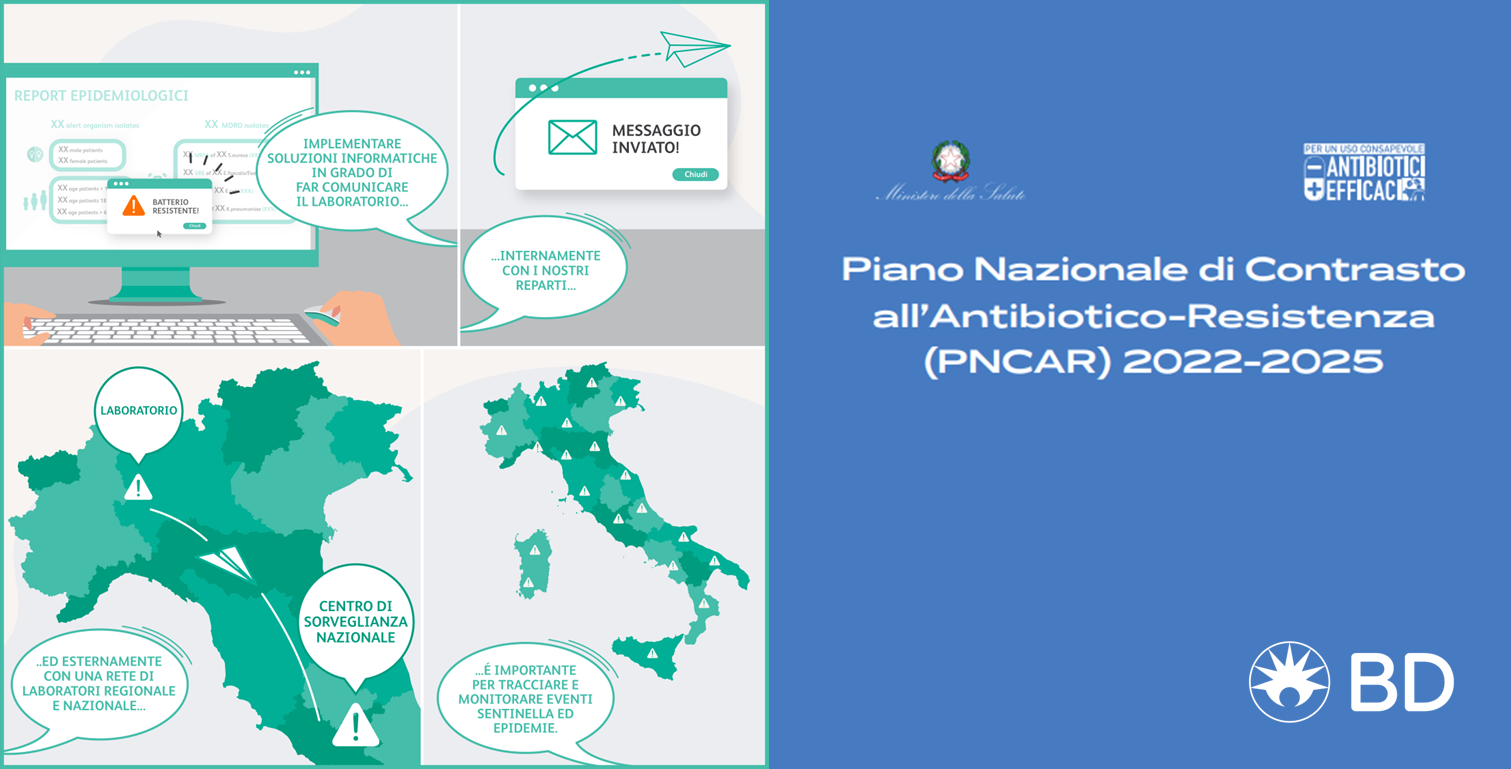The 2022-2025 New National Antibiotic Resistance Plan
Antibiotic resistance is a major global health emergency and requires increasingly decisive action by healthcare systems around the world. Microorganisms become resistant to pharmaceutical antibiotics due to their natural ability to acquire resistance to biocidal molecules through mutations in their genome.¹
The selective pressure caused by the overuse and misuse of antibiotic-acting drugs has caused the phenomenon of antibiotic resistance to reach significant levels with a subsequent serious clinical fallout.¹
One of the largest surveillance networks, Ears-Net, reports that more than 670,000 infections a year are caused by antibiotic-resistant bacteria.² In Italy, we know that about 7-10% of hospitalised patients suffer from multidrug-resistant bacterial infections and they are the cause for 4,500-7,000 deaths.³
 To address this concerning data, in August 2022 the Department of Regional Affairs and Autonomies published the 2022-2025 National Antibiotic Resistance Plan (PNCAR), which outlines the national strategy for countering antibiotic resistance¹. The goal of the document, in an updated version from the one published for the 2017-2020 four-year period, is to provide strategic operational guidelines to counter the problem in the coming years.¹ The strategies are based on the experience gained in recent years, European and international recommendations, and the experiences of other countries.¹ The vision guiding the multidisciplinary approach is that of One Health, whereby it is now widely recognised that human health is interconnected with environmental and animal health.¹
To address this concerning data, in August 2022 the Department of Regional Affairs and Autonomies published the 2022-2025 National Antibiotic Resistance Plan (PNCAR), which outlines the national strategy for countering antibiotic resistance¹. The goal of the document, in an updated version from the one published for the 2017-2020 four-year period, is to provide strategic operational guidelines to counter the problem in the coming years.¹ The strategies are based on the experience gained in recent years, European and international recommendations, and the experiences of other countries.¹ The vision guiding the multidisciplinary approach is that of One Health, whereby it is now widely recognised that human health is interconnected with environmental and animal health.¹
The document’s strategies are structured into three main areas:¹
1. Surveillance and monitoring
2. Infection prevention
3. Good use of antibiotics
Surveillance
The first pillar is surveillance, which aims to monitor the spread of antibiotic-resistant bacteria in the environment and their evolution, involving the human and veterinary spheres, in accordance with the One Health vision.¹ There are currently two surveillance services coordinated by the National Institute of Health (the antibiotic resistance surveillance, AR-ISS, and the surveillance of carbapenemase-resistant enterobacteria bacteremia, CRE). These services need to be bolstered throughout the country in order to:¹
● ensure greater coverage across the population;
● increase the frequency of reports;
● speed up data submission.
Integration with patient demographic and clinical data would provide a valuable set of information to work on in the coming years.¹
Care-related infections
Healthcare-associated infections (HAIs) must also be the subject of surveillance in order to take coordinated action. Data on infections need to be pooled with data on antibiotic therapy and prophylaxis administered to patients and data on the resistance profiles of microorganisms associated with HAIs.¹
This data will allow us to better define the problem, target actions to be taken, and evaluate their effectiveness. It will also be important in guiding choices for empirical antibiotic therapy to minimise antibiotic misuse.¹
Surveillance should be supported by an alert system that highlights the emergence and spread of new resistance and associated genotypes. Surveillance should be supported by an alert system that highlights the emergence and spread of new resistance and associated genotypes.¹
Monitoring
Monitoring refers to control over antibiotic use and environmental monitoring.¹ In terms of antibiotic use, Italy is one of the nations with the highest rates of consumption in Europe.¹ There is a need on the one hand to understand trends in antibiotic use and how to reduce inappropriate consumption, and on the other hand to verify and monitor the presence of pharmaceutical antibiotics in the environment. In fact, antibiotics that are improperly disposed of and found in soil and water play a role in accelerating, stabilising and spreading resistant bacteria.¹
Prevention
Infection prevention efforts are mainly directed toward healthcare-associated infections (HAIs) in hospital settings, which are now a real emergency, particularly in Italy. Prevention is also directed toward community infections and zoonoses.¹
There is a need for continuous and systematic data collection that is analysed in a coordinated way across the country. This can be crucial in activating and driving actions to prevent and curb the spread of communicable diseases.¹
BD’s commitment
BD has always been committed to countering antibiotic resistance through the development of a wide range of products and services that enable a diagnosis of a microbial infection to be achieved quickly and effectively; this is done with the support of systems for tracking and monitoring clinical microbiological data.
On the diagnostic side, BD Phoenix™ Emerge Panels is a system that can quickly and accurately detect antimicrobial resistance of gram-positive and gram-negative bacteria. It features 136 sensitivity test wells to test different antibiotics at various dilutions for each panel.
Regarding data monitoring and integration, BD has developed the BD EpiCenter™ Data Management System, an advanced system for comprehensive data management on a single platform designed specifically for microbiological diagnostics. The software enables the collection, storage and analysis of data (patient biographical and demographic data, test results and statistical-epidemiological analysis). The system communicates microbiology data from BD diagnostic tools to quickly identify organisms and help healthcare providers and decision makers to respond to potential threats of healthcare-associated infections and emerging resistances.
The BD Phoenix™ Emerge Panels and BD EpiCenter™ are therefore an advanced response to the needs dictated by the recent recommendations through rapid diagnosis, sample tracking, and making real-time data available to practitioners to facilitate timely, informed, and appropriate therapeutic decision-making.
DOWNLOAD THE BROCHURE
BD-84431
Bibliography
1. The 2022-2025 National Antibiotic Resistance Plan (PNCAR) 2022-2025. 2022-08-26
2. European Centre for Disease Prevention and Control. Surveillance of Antimicrobial Resistance in Europe 2018-Annual Report of the European Antimicrobial Resistance Surveillance Network (EARS-Net); European Centre for Disease Prevention and Control: Solna Municipality, Sweden, 2019. https://www.ecdc.europa.eu/en/publications-data/surveillance-antimicrobial-resistance-europe-2018
3. Lenzi A, et al. Concept Paper preliminare sulla antibiotico-resistenza in Italia. Presidenza del Consiglio dei Ministri Comitato Nazionale per la Biosicurezza, le Biotecnologie e le Scienze della Vita. 2021
BACK TO THE NEWS






 To address this concerning data, in August 2022 the Department of Regional Affairs and Autonomies published the 2022-2025 National Antibiotic Resistance Plan (PNCAR), which outlines the national strategy for countering antibiotic resistance¹. The goal of the document, in an updated version from the one published for the 2017-2020 four-year period, is to provide strategic operational guidelines to counter the problem in the coming years.¹ The strategies are based on the experience gained in recent years, European and international recommendations, and the experiences of other countries.¹ The vision guiding the multidisciplinary approach is that of One Health, whereby it is now widely recognised that human health is interconnected with environmental and animal health.¹
To address this concerning data, in August 2022 the Department of Regional Affairs and Autonomies published the 2022-2025 National Antibiotic Resistance Plan (PNCAR), which outlines the national strategy for countering antibiotic resistance¹. The goal of the document, in an updated version from the one published for the 2017-2020 four-year period, is to provide strategic operational guidelines to counter the problem in the coming years.¹ The strategies are based on the experience gained in recent years, European and international recommendations, and the experiences of other countries.¹ The vision guiding the multidisciplinary approach is that of One Health, whereby it is now widely recognised that human health is interconnected with environmental and animal health.¹